|
|
|
 |

 |
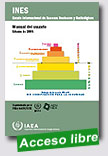 |
INES - Escala Internacional de Sucesos Nucleares y Radiológicos - Manual del Usario - Edición de 2008
OIEA, 2011, 230p.
La Escala Internacional de Sucesos Nucleares y Radiológicos (INES) fue elaborada en 1990 por un grupo de expertos internacionales convocado por el OIEA y la Agencia para la Energía Nuclear de la OCDE (AEN/OCDE) con el objeto de comunicar la importancia de los sucesos en instalaciones nucleares desde el punto de vista de la seguridad. Desde entonces, la escala INES se ha ampliado para atender la necesidad creciente de comunicar la importancia de cualquier suceso que produjera riesgos de radiación. A fin de satisfacer |
mejor las expectativas del público, la escala INES fue redefinida en 1992 y ampliada para hacerla aplicable a cualquier suceso relacionado con materiales radiactivos y/o con la radiación, incluido el transporte de materiales radiactivos. En 2001 se publicó una versión actualizada del Manual del Usuario de la escala INES a fin de aclarar el uso de la escala y perfeccionar la clasificación de los sucesos relacionados con el transporte y el ciclo del combustible. Se reconoció, sin embargo, que eran necesarias orientaciones adicionales y que ya se estaban realizando actividades al respecto, particularmente en lo relativo a los sucesos relacionados con el transporte.
Prosiguió la labor en Francia y en España sobre las consecuencias potenciales y reales de los sucesos relacionados con fuentes de radiación o con el transporte. A
petición de los miembros de la INES, las secretarías del OIEA y de la AEN/OCDE
coordinaron la preparación de un manual integrado que proporcionase orientaciones adicionales para clasificar cualquier suceso asociado a las fuentes de radiación y al transporte de materiales radiactivos.
Extraído de:
http://www-pub.iaea.org/MTCD/publications/PDF/INES-2008-S_web.pdf
|
 |
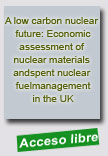 |
A low carbon nuclear future: Economic assessment of nuclear materials and spent nuclear fuel management in the UK
Smith School of Enterprise and the Environment (SSEE- University of Oxford), March 2011, 77 p.
The UK can realise a £10bn economic opportunity through adopting a new, holistic approach to nuclear energy that would tackle concerns over security of energy supply, rising oil prices and safety issues, a new report by the Smith School of Enterprise and the Environment (SSEE) has concluded.
A low carbon nuclear future: Economic assessment of nuclear materials and spent nuclear fuel management in the UK‘ explores possible future scenarios to accelerate the delivery of a safe, holistic and long-term strategy for current and future nuclear material and spent fuel management. It assesses likely costs, risks, safety and potential returns to the UK taxpayer |
and the wider economy, and looks at options for existing and new facilities at Sellafield. Professor Sir David King, Director of the Smith School of Enterprise and the Environment said: “Currently the UK has a window of opportunity to deal with its nuclear material and spent fuel management and to maximise the value of its existing assets. The renaissance in new nuclear build creates an advantageous way of using these legacy materials as fuel for new nuclear power plants. Despite the terrible events in Japan, the economic, safety and carbon case for a new build programme in the UK has never been stronger.
Our report evaluates scenarios that would reduce cost to the taxpayer and create billions of pounds of economic opportunity through new skills and jobs, as well as reducing carbon emissions and increasing energy security and safety. The potential benefits of examining nuclear materials and spent fuel stocks as a potential asset and managing these alongside new build reactors, through an all encompassing UK nuclear power policy, are clarified through this investigation.”
In considering the policy levers enabling the safe management of our nuclear legacy – through storage, reprocessing or disposal – the report concludes that the “do nothing” option will lead to the worst outcome for the taxpayer and for the UK’s future security.
Separated plutonium, uranium, current spent AGR fuel and waste generated by future reactors must be tackled. The UK needs to choose to follow strategies that treat these as a resource for recycling into new fuel, with considerable economic benefits for the UK and particularly for West Cumbria. The UK’s nuclear clean-up missions have not kept up with new nuclear build plans and need to be reviewed.
Extraído de:
http://www.smithschool.ox.ac.uk/a-low-carbon-nuclear-future-economic-assessment-of-nuclear-materials-and-spent-nuclear-fuel-management-in-the-uk |
 |
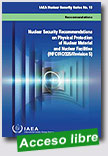 |
Nuclear Security Recommendations on Physical Protection of Nuclear Material and Nuclear Facilities
IAEA Nuclear Security Series, 2011, 76 p.
This publication, Revision 5 of Physical Protection of Nuclear Material and Nuclear Facilities (INFCIRC/225) is intended to provide guidance to States and their competent authority on how to develop or enhance, implement and maintain a physical protection regime for nuclear material and nuclear facilities, through the establishment or improvement of their capabilities to implement legislative and regulatory programmes. The recommendations presented in this publication reflect a broad consensus among Member States on the requirements which should be met for the physical protection of nuclear materials and nuclear facilities. |
Extraído de: http://www-pub.iaea.org/MTCD/publications/PubDetails.asp?pubId=8629
|
 |
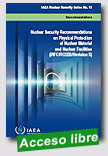 |
La radiación ionizante y la radiación no ionizante son temas bastante complejos y abstractos, especialmente para explicárselo al alumnado de menor edad. Por otra parte, estas materias no están incluidas dentro de la enseñanza obligatoria para los cursos de secundaria en nuestro país, por lo que se tratará de materias transversales para impartir si el profesorado lo estima oportuno. |
Esta guía didáctica presenta un “programa en espiral”, que significa que los diferentes temas reaparecen en los dos niveles aumentando en complejidad. Este mismo enfoque tenía la guía didáctica para centros de enseñanza primaria, ambos volúmenes se han concebido como obras independientes aunque complementarias.
El material aquí contenido ha sido concebido para su utilización en la enseñanza secundaria y se divide en dos niveles, según la edad: 12 a 16 años (Enseñanza Secundaria Obligatoria) y de 16 a 18 años (Educación secundaria postobligatoria: Formación Profesional y Bachillerato). Cada nivel puede ser impartido como una unidad completa, aunque los profesores son libres de emplear material de unidades anteriores o posteriores. Por consiguiente, el manual podría considerarse como una fuente de material de referencia para que el profesor construya sus propias unidades y se completa con un amplio suplemento técnico. En estos dos niveles se subraya en especial la relación entre la radiación y las experiencias y observaciones cotidianas y personales de los alumnos y alumnas para que se sensibilicen sobre los riesgos y beneficios de la radiación ionizante y no ionizante.
Extraído de:
http://www.csn.es/images/stories/publicaciones/
otras_publicaciones/guia_radia_web.pdf |
 |
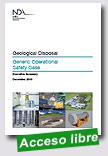 |
Geological Disposal - Generic Operational Safety Case Executive Summary
Nuclear Decomissioning Authority (NDA - UK), December 2010, 13 p.
The generic Operational Safety Case (OSC) presents the safety case for construction, operations, decommissioning and closure of the geological disposal facility (GDF ) and is supported by a number of more detailed assessment reports. These reports are in turn supported by a number of specifi cally commissioned reports, as well as a great deal of wider scientifi c literature. |
Extraído de:
http://www.nda.gov.uk/documents/loader.cfm?url=/
commonspot/security/getfile.cfm&pageid=44205 |
 |
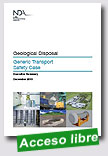 |
Geological Disposal - Generic Transport Safety Case Executive Summary
Nuclear Decomissioning Authority (NDA - UK), December 2010, 13 p.
The aim of the generic Transport Safety Case (TSC) is to demonstrate that the transport operations to move radioactive waste from the waste producers’ sites to the site of a GDF can be achieved safely with radiation exposures below allowable limits and as low as reasonably practicable (ALARP). It would provide information to the regulators, the public, other stakeholders and ourselves that the transport operation is justifi ed and that exposure to ionising radiations can be limited. We
aim to provide confi dence that radioactive waste transport operations will meet the regulatory requirements.
|
Extraído de:
http://www.nda.gov.uk/documents/loader.cfm?
url=/commonspot/security/getfile.cfm&pageid=44210
|
 |
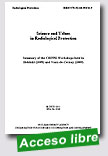
|
Science and Values in Radiological Protection
Summary of the CRPPH Workshops held in Helsinki (2008) and Vaux-de-Cernay (2009)
Nuclear Energy Agency (NEA), 2011, 125 p.
Decisions regarding radiological protection are informed by science, including its uncertainties, influenced by stakeholder concerns, driven by prevailing circumstances, and broadly based on values and judgments. However, the processes by which protection decisions are taken do not always sufficiently articulate the scientific and value-judgment elements on which decisions are based. To assist decision makers at all levels to further clarify the various aspects of their decisions, and to assist
|
scientists and regulators in better understanding each other’s contributions to radiological protection decisions, the NEA Committee on Radiation Protection and Public Health (CRPPH) has held two workshops addressing science and values in radiological protection. This report summarises the discussions and conclusions of the first two workshops in this innovative series, and suggests the way forward in preparing the discussions at the third science and values workshop.
Extraído de:
http://www.oecd-nea.org/tools/publication/index/period/6m/sort/date/filter/1#p6364 |
 |
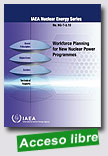 |
Workforce Planning for New Nuclear Power Programmes
IAEA Nuclear Energy Series, 2011, 113 p.
The nuclear power field, comprising industry, government authorities, regulators, research and development organizations and educational institutions, relies for its continued success on a specialized, highly trained and motivated workforce. The aim of the present publication is to provide information on the use of integrated workforce planning as a tool to effectively develop these resources for the spectrum of organizations that have a stake in nuclear power programmes. It is based on the framework contained in the IAEA publication, Milestones in the |
Development of a National Infrastructure for Nuclear Power, and addresses the workforce requirements for each of the three phases, focusing on three main organizational entities (NEPIO, regulatory body and operating organisation) and their responsibilities in relation to each of the 19 Infrastructure issues. It also includes actual case studies to illustrate how other Member States have implemented or are implementing their first nuclear energy programme.
Extraído de:
http://www-pub.iaea.org/MTCD/publications/PubDetails.asp?pubId=8488 |
 |
 |
Evolution of ICRP Recommendations – 1977, 1990 and 2007
Changes in Underlying Science and Protection Policy and Case Study of Their Impact on European and UK Domestic Regulation
Nuclear Energy Agency (NEA), 2011, 112 p.
Radiological protection philosophy, regulation and application have evolved significantly over the last 30 years, adapting to the ever-changing landscapes of scientific understanding and societal values. This report provides a methodical assessment of these changes. Starting with radiological protection in the |
1970s, it describes the philosophical differences between International Commission on Radiological Protection (ICRP) Publication 26, issued in 1977, and ICRP Publication 60, issued in 1990, as well as the regulatory evolution that was necessary to effectively implement the changes. It then examines the philosophical and regulatory changes between ICRP Publication 60 and ICRP Publication 103 of 2007. Although the regulatory changes needed to implement Publication 103 are, in practice, yet to come, the report provides a seasoned view of what these changes will most likely be, and what efforts will be necessary to successfully implement them.
Extraído de:
http://www.oecd-nea.org/rp/reports/2011/nea6920-ICRP-recommendations.pdf
|
 |
| 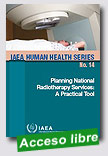
|
Planning National Radiotherapy Services: A Practical Tool
IAEA Human Health Series, 2011, 83 p.
The current and future burden of cancer incidence in developing countries requires the planning, establishment and upgrade of radiotherapy services at the national level. This publication is a practical guide outlining the main issues at stake when planning national radiotherapy services. It provides an assessment of the cancer burden, evaluates the existing resources and determines what is needed and how to cover the gap in a resource-oriented rational way. The publication will be of practical value to decision makers and programme managers in public health facing the organization or re-organization of radiotherapy in their countries. |
|
|
|
|
|
|
